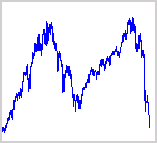 Menu
Menu
 Menu
Menu

The financial community in general has promoted the “Buy-and-Hold” strategy for many years as the only acceptable approach to investing. The last two bear markets put Buy-and-Hold to the test as the fortunes of some who followed it were cut in half. It may happen again in the next. This raises the questions:
| Is buy-and-hold smart? | Sometimes |
| Should you use a buy-and hold approach? | Maybe |
| Is there another approach? | Yes |
LFM&P believes that you should understand the basis of the advice you are being given and design your investment strategy accordingly. You should not blindly follow the conventional wisdom, no matter how often it is repeated.
Buy-and-Hold has been repeated for such a long time in the retail financial industry that it has become the commonly accepted conventional wisdom. This is surprising, because Buy-and-Hold is counter-intuitive. A person's natural response is to protect capital from loss. As a quote attributed to both Will Rogers and Mark Twain says, "I’m more concerned about the return of my money than with the return on my money”. Or alternatively, that wise financial philosopher, Anonymous, said, "It is not how much you earn that is important. It is how much you keep".
Historically, investors have been strongly encouraged disregard their normal reactions and follow a Buy-and-Hold approach for a number of reasons. Some of the reasons are good. Some are not so good. Here is a summary:
Investor’s emotions are their worst enemy. People are most optimistic at market peaks when risk is highest, and most afraid at market bottoms when risk is actually the lowest. Stoically following a Buy-and-Hold approach keeps investors from selling their positions at just the wrong time -- at market bottoms. Unfortunately, however, the accompanying wealth destruction during down markets may give you indigestion and sleepless nights in the process, as well as delaying or destroying your retirement plans.
In a strongly trended bull market, like the recent one, and also in the late 1990’s, when prices move higher most of the time and downward corrections are short-lived, Buy-and-Hold will produce the best gains. It is difficult to improve on the performance provided by a strong up-trend, even by trading most nimbly.
Buy-and-Hold is easy. It is easy for the investor who has limited time to keep abreast of his holdings. It is also easy for the financial advisor who has many clients to advise and many accounts to review. It is easier for mutual fund managers’ portfolio adjustments, if their client investors do not add and remove money frequently. Interestingly though, most mutual fund managers do not follow their own advice. Most actively trade the investments in their fund portfolios, attempting to gain an advantage.
Historically, the stock market has risen 2/3 of the time and fallen 1/3 of the time. Buy-and-Hold puts the long-term investor on the right side of the market trend the majority of the time.
Years ago, before the advent of low-cost discount brokers, it was very expensive to trade stocks or mutual funds profitably on a short-term basis. A single round trip transaction could cost 4%. Securities regulators were on the lookout for brokers that “churned” accounts, buying and selling rapidly to earn large commissions. Today, however, there are plenty of low-cost brokerage alternatives, so transaction costs need not be an important consideration.
When markets rise off a bottom, they often rise quickly. The industry tries to “prove” the importance of Buy-and-Hold with the following type of logic that you may have seen at one time or another:
The S&P 500 average gained 4060% between 1950 and 2004. If you had been out of the market for just the 10 best days, you would have only gained 2214%, a substantial reduction of 45.4%!
What they fail to mention in this specious argument is, if you had been out of the market the 10 best days, and the 10 worst days, the results would have actually been better. You would have actually gained 4594%, an improvement of 13%!
This calculation is not meant to suggest that a person could be smart enough to sidestep the 10 worst days any more than they might be unfortunate enough to miss the 10 best days. It suggests that this widely promoted “proof” of the value of Buy-and-Hold” is bogus.
Given these good reasons, it is understandable why the financial industry advises Buy-and Hold, particularly from the perspective of its own benefit. What is the fundamental problem with the Buy-and-Hold approach?
When brokers and other advisors tout Buy-and Hold, it is because this strategy produces the best gains over the long-term without substantial knowledge, intervention and effort on their part. The problem is that gains are only one consideration for investments. The other major consideration is risk. The significant volatility since 2000 has underscored the problem with the approach. Risk is a most important consideration for people who do not have the luxury to invest solely for the long term, such as people in, or nearing, retirement.
Years ago, retirees could count on pension funds to guarantee much of their retirement income and reduce their reliance on investment returns. With the advent of the 401(k), IRA, and 403(b) plans and the concurrent demise of the employer-sponsored pension plan, retirees have, perhaps unknowingly, personally acquired far more investment risk than they had before.
If Buy-and Hold is easy and effective, why isn't everyone rich? Buy-and-Hold subjects investors to the kind of large and unnecessary risk that was recently experienced in the last bear market, destroying wealth and personal plans. Buy-and-Hold not only produced greater than a 40% loss for stock investments in 2000-2002 (-43%) and again in 2007-2009 (-57%), holding stocks produced no return (that’s right -- 0%, including dividends) from January 2000 to September 2011. In the interim, the approach risked fortunes, retirement plans, college education plans and the living standard of retirees who depend on investments.
The way to reduce some of the risk inherent in using Buy-and-Hold is to make sure that a portfolio is diversified and holds different types of assets. Bonds are a primary tool that will reduce risk when added to a portfolio. Passively diversifying in this manner reduces risk somewhat, but also reduces the potential for long-term return at the same time.
Has Buy-and-Hold worked well recently? Will it work will in the future? Yes, at some times, not at others. There are two types of individuals who may be able to use Buy-and-Hold most effectively. They are:
1) Young workers who have decades to invest before retirement, who can meet their living expenses comfortably from their income, and who have no plans to liquidate their holdings in the foreseeable future.
2) People who have investment assets that are more than 25 -30 times what their anticipated investment income needs are, or will be, in retirement.
These people have the common characteristic. They can tolerate volatility and risk well. For average people, who are investing to improve their financial future, or are in or nearing retirement, Buy-and-Hold can be an unnecessarily risky approach. These are the people who cannot tolerate excessive risk and face the asset allocation trade-off. They must either be exposed to the possibility of excessive principal loss, or earn the reduced returns and retirement income that accompany a more conservative investment allocation. Neither choice is desirable.
The alternative is to adopt a different way of managing risk. Advisors can serve their clients better by focusing on actively managing risk. LFM&P developed the MarketAwareSM approach to address this need. As long as markets remain volatile and economic growth is retrained or unpredictable, we suspect that the practice of active risk management will continue to gain momentum among those independent advisors who value providing true individual advice and individual financial management.
18-9-k